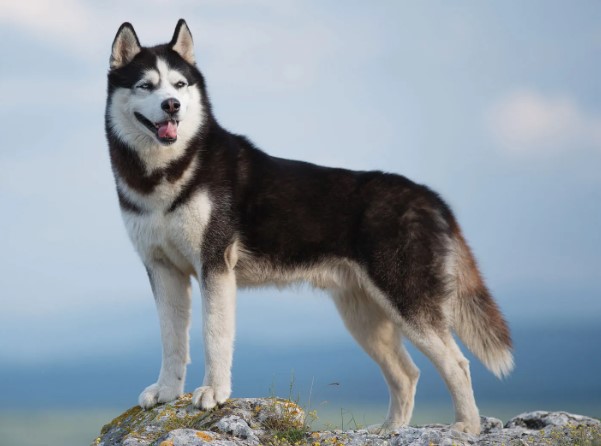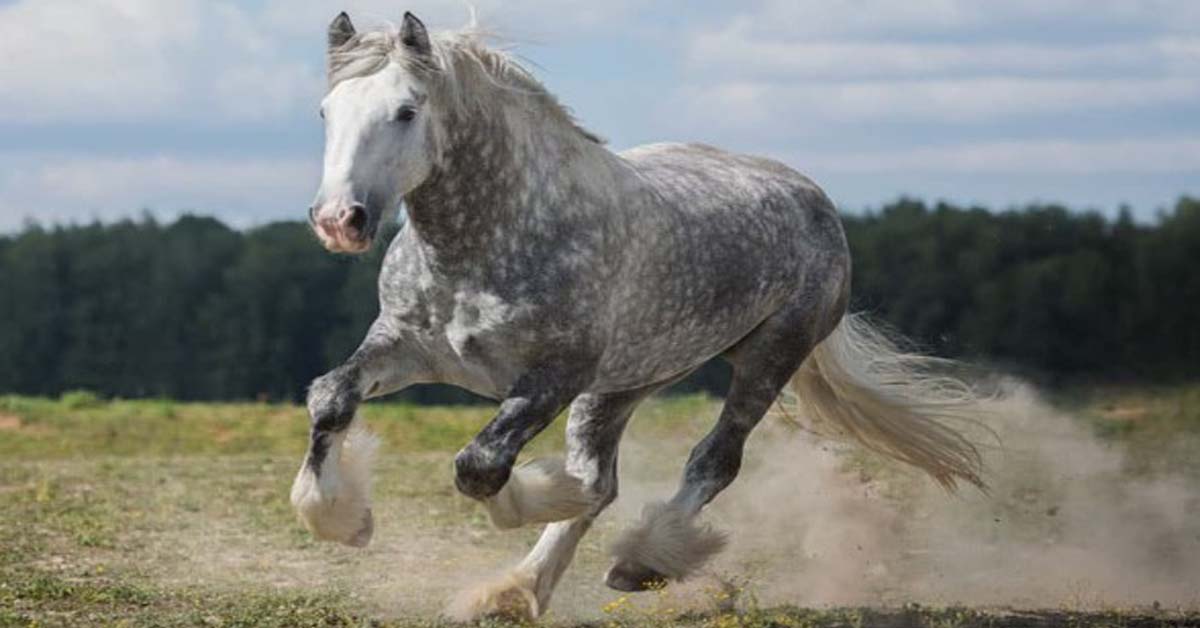The Giant Schnauzer, originating in 17th-century Germany, is a robust breed of dog renowned for its size and distinctive characteristics. Among the Schnauzer family, which includes the Standard Schnauzer and the Atomic Schnauzer, it stands as the largest variant. Its development involved the integration of various breeds, such as the black Great Dane, the Bouvier des Flandres, and the German Pinscher.
Originally bred for agricultural purposes, the Giant Schnauzer was tasked with herding livestock and safeguarding the farmer’s land. Over time, its role expanded to urban settings, where it found employment guarding breweries, warehouses, livestock yards, and factories. While its presence was confined mainly to Bavaria initially, it gained prominence during both World War I and World War II as a valued military canine.

Characterized by a dense and coarse coat, the Giant Schnauzer boasts protection against both inclement weather and pests. Its coat comes in three distinct colors: pepper and salt, solid black, and black with markings of tan. In regions where permitted, these dogs are often seen with cropped ears and docked tails, further accentuating their unique appearance, which includes their trademark beards and eyebrows.
Today, the Giant Schnauzer actively participates in a variety of canine sports, including Schutzhund and agility courses. Its innate alertness also makes it a valuable asset in police work and other security roles.
- Origin: Germany
- Height: 60-65 cm ( female), 65-70 cm ( male)
- Weight: 25-34 kg (female), 27-48 kg (male)
- Giant Schnauzer Lifespan:12-15 years
- Giant Schnauzer Colors: black gray fawn
Breed Characteristics
The Giant Schnauzer, a magnified and esteemed version of the Standard Schnauzer, is expected to embody the essence of boldness and gallantry, as stipulated by the breed standard. Its exceptional intelligence and unwavering loyalty render it not only an exemplary worker but also a cherished companion.
Resembling the Standard Schnauzer in appearance but larger in size, the well-bred Giant Schnauzer stands as a commanding presence. True to their name, these giants can reach heights of up to 27.5 inches at the shoulder and weigh as much as 95 pounds. Their robust and muscular physique epitomizes the breed’s description as a “bold and gallant figure of a canine.”
The thick double coat of the Giant Schnauzer comes in two variations: solid black or a mixture known as “pepper and salt.” Prominent features shared with the Miniature and Standard Schnauzers include a coarse beard and expressive eyebrows, which contribute to their sharp and perceptive countenance.
| Energy level: 3/5 Point | Friendship for strangers: 1/5 Point |
| Exercise requirements: 4/5 Point | Vigilance: 5/5 Point |
| Playfulness: 4/5 Point | Ease of training: 3/5 Point |
| Affection level: 1/5 Point | Fitness requirements: 3/5 Point |
| Friendship for dogs: 1/5 Point | Heat sensitivity: 3/5 Point |
| Friendly to other pets: 2/5 Point | voice: 5/5 Point |

History Of Giant Schnauzers
The origins of the first Giant Schnauzers trace back to the regions of Swabia and Wurttemberg, where a particular canine caught the eye with its robust physique and impeccable conformation. Despite the Bavarians’ fondness for dogs, they sought a larger breed, leading to the development of the Giant Schnauzer.
Historical records suggest a close association between the Giant Schnauzer and the Bouvier des Flandres, a renowned herding dog from Flanders. In the late 19th century, breeders in Germany began refining the breed, aiming for a larger size compared to its original counterpart.
With the decline of cattle herding due to advancements in transportation, Giant Schnauzers found new roles as police and military canines across Europe. Renowned for their bravery and loyalty, they became esteemed protectors of households and loved ones, especially in America, where their dense coat was believed to offer protection against harsh weather and potential threats.
Initially bred as versatile ranch dogs for property management and livestock handling, Giant Schnauzers gained popularity steadily over the years. The American Kennel Club recorded a significant increase in registrations, from 23 in 1962 to approximately 1,000 by the mid-1980s.
While evidence shows that they are important in some regions, many European Schnauzer clubs prioritize performance trials over traditional shows. In countries like Germany, dogs are required to attain titles in field trials and championships to be considered successful representatives of the breed.
Appearance
The towering and robust Giant Schnauzers are hard to overlook. Similar to their smaller counterparts, they boast a dense, wiry coat that typically comes in black or a pepper-and-salt combination, although variations in fawn or black and tan are also observed. Their distinctive beard and expressive eyebrows, framing their deep, dark eyes, often require regular trimming to maintain their sleek appearance.
Being low shedders, Giant Schnauzers may be suitable companions for individuals with allergies, although consistent grooming is essential to keep their wiry coats tidy and in optimal condition. While no dog breed can guarantee complete hypoallergenicity, Schnauzers of all sizes are widely regarded as favorable choices for those with canine sensitivities, although individual reactions may vary.
Before committing to bringing a Giant Schnauzer puppy into your home, it’s advisable to spend time with the breed to gauge how your allergies may respond to their presence.
Giant Schnauzer Temperament
The playful and spirited Giant Schnauzer can sometimes be too lively for small children, despite being generally well-behaved with kids within their own family circle. They exhibit boldness and loyalty to their family members but tend to be reserved around strangers. Additionally, they may display assertiveness towards other dogs.
This intelligent and energetic breed is an excellent option for active individuals seeking a companion for outdoor adventures. However, it’s important to note that Giants may occasionally exhibit leadership tendencies and may attempt to assert themselves as the alpha in the relationship.
Giant Schnauzers Personality
Composed, vigilant, courageous, easily trained, deeply loyal to their family, playful, graceful in repose, and commanding when provoked—these characteristics define the Giant Schnauzer.
With its reliable temperament, robust physique, and weather-resistant wiry coat, the Giant Schnauzer stands out as one of the most versatile and enduring working breeds.
This breed requires ample exercise to thrive. Regular walks, playtime, and even accompanying you on jogs are essential for their well-being. Failure to provide sufficient physical activity may lead to the Giant Schnauzer inventing its own games, which could involve romping through the house, chasing children, and generally causing mischief as a manifestation of boredom and restlessness.
While allowing a Giant Schnauzer puppy to exercise in the yard may result in some unintended landscaping, given their boundless energy, it’s crucial for their mental and physical health.
In addition to their energetic nature, Giant Schnauzers are also protective of children and tend to be territorial. They perceive it as their duty to safeguard their family, sometimes expressing this through growling and barking to assert their boundaries.
Health
Surprisingly, Giant Schnauzers boast a longer-than-average lifespan of 12 to 15 years despite being a large breed, and they encounter relatively few health problems. According to Frieman, this may be attributed to their less widespread popularity.
“When there’s a high demand for a particular breed, it can lead to genetic issues because not all breeders are as diligent in screening out potential health issues,” Frieman explains.
Giant Schnauzer owners should remain vigilant regarding the risk of gastric dilatation-volvulus (GDV), commonly known as bloat—a serious condition where the stomach twists, cutting off blood flow and potentially leading to death within hours. However, there are preventive measures that can be taken.
“During the spaying or neutering process for dogs of this size, we recommend a simple procedure called gastropexy, which attaches the stomach to the body wall, reducing the likelihood of twisting,” Frieman advises. “It’s a straightforward decision for anyone considering owning a large breed dog.”
Similar to other large breeds, Giant Schnauzers may also experience issues like hip and knee dysplasia. Frieman recommends discussing these concerns with your breeder to gain a comprehensive understanding of any medical history within their lineage. Additionally, regular veterinary check-ups are essential for early detection of any potential health issues.
Health Problems In Giant Schnauzers
Orthopedic issues are prevalent among Giant Schnauzers, often causing discomfort and lameness. These conditions include osteochondritis, panosteitis, and hypertrophic osteodystrophy.
A study conducted by Michigan State University’s thyroid database revealed that over 20 Giant Schnauzers are afflicted with thyroid disorders. Additionally, they may experience heart and cancer-related health issues.

Care Tips For Giant Schnauzer
Giant Schnauzers are not ideally suited for apartment or condo living due to their high energy levels and need for outdoor space. They thrive best in homes with fenced yards where they can freely expend their energy. Indoors, they prefer to be close to their human companions, often following them around the house.
Providing at least an hour of daily exercise is essential for Giant Schnauzers. This can include brisk walks or vigorous play sessions to keep them mentally and physically stimulated. Given their propensity for digging and chewing, it’s important to offer them constructive activities to channel their energy.
This breed craves mental stimulation and benefits from having a job to do. Training them in tricks or involving them in household tasks can help prevent destructive behaviors. However, training should be approached with patience and consistency, avoiding repetitive drills and instead turning it into an engaging game.
Working with a trainer familiar with the breed’s characteristics can yield positive results, as Giant Schnauzers respond well to enthusiastic and positive reinforcement.
Regular dental care, including brushing teeth several times a week, is necessary to prevent tartar buildup and maintain oral health. Additionally, nails should be trimmed every one to two months to prevent overgrowth, ensuring they remain at a comfortable length and minimizing the risk of scratching.
Best Food For Giant Schnauzer
- Hills Prescription Diet b/d Chicken Flavor Dry Dog Food
- Hill’s Prescription Diet h/d with Chicken Wet Dog Food
- Hills Bioactive Recipe Adult Small Breed Dog Food
- Hill’s Science Diet Adult Small Paws Savory Stew with Chicken & Vegetables Dog Food
Feeding
It is recommended to feed your Giant Schnauzer a daily amount of 3 3/8 to 4 1/4 cups of high-quality dog food, divided into two meals.
The quantity of food your adult dog requires depends on factors such as size, age, body condition, metabolism, and activity level. Just like people, dogs are individuals, and their nutritional needs vary. An active dog will typically require more food than a less active one.
The quality of the dog food you choose also plays a significant role. Opting for higher-quality dog food ensures better nutrition, meaning you may need to feed less compared to lower-quality options.
To maintain your Giant Schnauzer’s optimal body condition, it’s important to measure their food and feed them twice a day rather than leaving food out continuously. Regularly assess your dog’s body condition by visually inspecting their waistline and feeling their ribs. You should be able to see a slight waistline and easily feel their ribs without pressing too hard. If you’re unsure, consult with your veterinarian or a pet nutritionist for personalized feeding recommendations.
Due to the risk of gastric torsion, it’s advisable to feed Giant Schnauzers two to three small meals per day to prevent the buildup of gas.
For more guidance on feeding your Giant Schnauzer, refer to our recommendations for selecting the right food, feeding puppies, and feeding adult dogs. Ultimately, specific feeding recommendations should be provided by your veterinarian or a pet nutritionist, but as a general guideline, Giant Schnauzers typically require 3 3/8 to 4 1/4 cups of high-quality dog food daily, split into two meals.
Grooming
The Giant Schnauzer boasts a dense, weather-resistant double coat, consisting of a soft undercoat and a coarse outer coat. To keep their coat healthy and attractive, they require weekly brushing and regular trimming or stripping.
Owners should be ready to invest time in grooming their Giant Schnauzer’s coat or arrange for professional grooming services recommended by the breeder. It’s important to regularly check the ears for signs of infection and brush the teeth frequently using toothpaste specifically formulated for dogs.
Training
Exceptionally intelligent and fiercely protective, the Giant Schnauzer forms a deep bond with its owners and takes on the role of their guardian with great dedication. Quick to learn and discerning in nature, they possess a keen ability to differentiate between friend and foe. Giants thrive on companionship and detest being left alone or neglected in the yard.
Providing a job or even a simple activity like fetching a ball is crucial for the well-being of a Giant Schnauzer. Renowned for their high energy levels and strong territorial instincts, they are best suited for committed owners who can provide them with a fenced-in area for exercise, regular physical activity, and mental stimulation.
Giant Schnauzers excel in various canine sports, including herding, agility, tracking, and obedience. Early socialization and enrollment in puppy training classes are essential for this robust and protective breed to channel their strength and instincts positively.
Exercise
This breed necessitates approximately 45 to 65 minutes of daily exercise and activity. This regimen should consist of consistent walks supplemented with purposeful physical activity and vigorous exercises. Given their high intelligence, they also require ample mental stimulation and enrichment.
Neglecting to fulfill the daily exercise needs of your Giant Schnauzer can result in behavioral issues and may pose challenges in managing their temperament. Regular walking, mental enrichment activities, swimming, and other forms of conditioning are essential for maintaining the overall health and well-being of this breed.
Adoption Center
Other Dog Breeds and Further Research
FAQs
Giant Schnauzer PuppyDog price
The Giant Schnauzer puppy dog cost is more than $,000.
Do Giant Schnauzers suck?
Although Giant Schnauzers are known to be guard tykes, the habit of biting isn’t considered a normal and respectable gesture. In nature, Giant Schnauzer puppies tend to suck when they engage in play. As they develop, this type of geste isn’t demanded or not necessary presently.
What two types make a Giant Schnauzer?
Giant Schnauzer History
The Giant Schnauzer strain is a cross between the “ bear Schnauzer ” and black Great Dane, which accounts for their shorter hair and larger body, creating a nobility working canine who can also serve as a family guard canine.
How good is a Giant Schnauzer?
The Giant Schnauzer is good-natured but can be relatively dominant. generally friendly toward other tykes, Giant Schnauzers love to be around their families and children, making them ideal family faves. Giant Schnauzers are veritably pious, devoted, and defensive of their people — good traits for a guard canine.
Are Giant Schnauzers intelligent?
These are veritably large, important, and energetic tykes. But they are also pious, smart, and trainable. This makes them a great choice for possessors who are willing to make the commitment and put in the work.












One thought on “Giant Schnauzer Dog Breed And Characteristics Information”